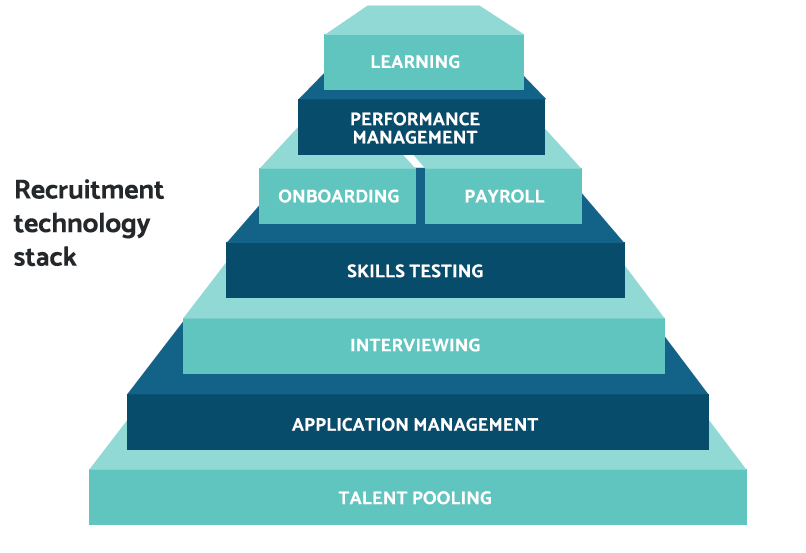These days, recruiting employees without the help of recruitment tech is almost unthinkable. With new software popping up almost every day, you and your internal recruitment team might feel lost and overwhelmed by choosing the right software. This unbiased guide written by our Product Manager James Keele explains how to evaluate your current processes, the pros and cons of open and closed tech, and how to ask potential providers the right questions. Download a copy of this free guide to learn how to select the right technology in line with your recruitment and overall organisational goals.
To download the guide, submit your details using the form below.
Introduction: What is a recruitment tech stack?
Essentially, a recruitment technology stack, a “rec-tech stack” is the software you use for your recruitment process. It can be as simple as spreadsheets and inboxes, or a full end-to-end process with software catering to talent attraction and acquisition, application management, behavioural testing, interviewing and onboarding.
Depending on your organisation’s needs and circumstances, you’ll likely find yourself somewhere in between, with some manual processes interspersed with software and other technology tools.
Level 1: Evaluate
Should you change or update your existing tech?
To take the first step in evaluating your “rec-tech” stack – and whether or not you need to expand or consolidate it – you need to evaluate your existing processes and users. Ask the right questions to break down your decision-making process into smaller categories.
In the first part of your evaluation process, consider the following.
Are you happy with your existing core product?
The core product/s you use form the foundation of your existing recruitment process. If you’re happy with your existing core product, you can explore adding tools and outsourced services to your suite. If it’s just not working in the way you need it to, you may need to lay a new foundation with a different core product.
How difficult is it to change?
Implementing new software and outsourced services come with their own challenges. You may need to determine quick wins you can implement immediately, or create plans for medium to long-term projects.
What resources and budget do you have available?
If you need to make a change, what changes are realistic for your organisation? Advanced software might revolutionise your processes, but it won’t be worth it if it breaks the bank.
Identifying strengths and weaknesses
Assess the weaknesses in your current recruitment process and team. Ideally, you’re looking to find solutions that bolster your weaknesses.
What resources and budget do you have available?
If you need to make a change, what changes are realistic for your organisation? Advanced software might revolutionise your processes, but it won’t be worth it if it breaks the bank.
Where is your organisation strong, and where is it weak?
- Employer branding
- Talent attraction
- Ad copy and positioning
- Managing and responding to applications
- Shortlisting & Selection
- Interviewing
- Behavioural testing and interpretation
- Background checks
- Reference checks
For each of the above, decide whether you’d like to explore solutions to solve your weaknesses with software, outsourcing or internal management.
Download the free printable guide to complete the worksheet
Exploring solutions
So, you’ve started by identifying your team’s capabilities, which will give you some peace of mind and help you create an action plan. (Tip: we conduct regular check-ins, as people are constantly learning and upskilling.)
Now, here’s what might just be the most fun part of the process! Exploring solutions.
In thinking about the types of solutions you want to explore, consider the following:
- Do you want to focus on AI-powered and automation solutions?
- Who are your users and what are their needs and priorities? (Ease of use, expansive features?)
- attraction
- What is your organisation’s appetite/tolerance for change?
- Are you looking for specialised features, or an all-in-one solution?
- How difficult will a solution be to implement? (Note: if your users can’t or won’t change, new
- software will not improve anything!)
Consider the pros and cons of an end-to-end “all in one” recruitment tech stack and a custom “interconnected” recruitment tech stack.
It’s easy to feel intimidated by the sheer amount of options available, but by starting your assessment using this process, you’ll be able to quickly narrow down areas for improvement and start making some really powerful decisions. Often, the hardest part is getting started. So let’s dive into the next stage: creating an action plan!
Be honest about your starting point before deciding where outsourcing or adding software to your processes will provide the best benefit.
Level 2: Creating an action plan
Find a starting point
So far, you’ve identified areas where your organisation’s recruitment is weak, where it is strong and the capabilities of your existing team. It’s time to consider the following three options to identify a starting point.
Your earliest point of weakness
A useful place to start can be the earliest point in your recruitment process that you need software or outsourcing to fill the gap.
Choosing a theme
There are many questions to ask and opportunities to consider, so picking a theme can help you make the right decisions down the road. Understand exactly what your needs are and the problems you’re trying to solve to narrow your search for the right solutions, and ask the best questions of potential providers.
Here are some potential “themes” to consider:
- Do you have the resources to embrace some advanced tech in AI and machine learning?
- Do you need a tool to automate your processes to free up resources in other areas?
- Do you need tech that’s, above-all, simple and easy to use and understand? (Note: options like this can lack certain features and complexity, but keep your users’ needs in mind.)
Envisioning your ideal recruitment process
Your first point of weakness or choosing a theme are two options that might seem easy at face value, but they don’t always work as an ideal starting point.
You may not like your current software suite at all. If that’s the case for you, start instead by working your way back from what your ideal recruitment process might look like. This might give you more clarity about how to build each stage of your process.
This alternative strategy comes with its own challenges, but if you know what your ideal recruitment process is, you can use it to guide your decision-making process.
Getting in touch with potential providers
Based on your preferred starting point, you may have some ideas about the type of solutions you want to explore.
Here are some potential questions to consider prior to getting in touch with potential providers:
- How does this solve my problem?
- Will my team embrace it?
- Is it flexible and scalable?
- Does the solution come from software, outsourcing, or my internal team?
- Can we make the process seamless?
Level 3: Your ideal solution
How do you know when you’re finished?
With so many options available, it’s easy to jump down the rabbit hole of expensive solutions and end-to-end offerings from providers who promise you the stars. Who knows, they might be telling the truth! But we recommend exercising caution and discipline.
You can always add more to your suite. But the last thing you want to do is add expensive or unnecessary tools and processes to your tech stack that don’t suit your needs.
Understand and determine which processes you need to replace or improve. Weigh up implementing new software and outsourcing processes against the challenges of training your new team and the potential impact on productivity.
Because your recruitment process is finite, know you’ll get the best results by determining your ideal process and solving any challenges within that framework. Once you have shored up your areas of weaknesses, your rec-tech stack is complete. If you expand your process in the future and further gaps open up that need to be addressed, simply consult this guide again and reassess before taking action.
Knowing that you’ve implemented the right solution (software, outsourcing and your internal team), will feel like a puzzle piece sliding in place.
Trust yourself, don’t over-engineer your processes, and deliver what you know. You’ve got this!
Summary
In building your ideal rec-tech stack, assess your current tech and the capabilities within your existing team. If you’re happy with your existing core product, supplement your processes with additional tech or outsourced services. If your current core product is unsatisfactory, explore options to lay a new foundation, and build your ideal process from there.
Be realistic in evaluating your strengths and weaknesses to identify areas for improvement through software, outsourcing or internal management. Determine whether your organisation is best suited to an all-in-one solution, or an interconnected solution.
In creating an action plan, determine a starting point from your earliest point of weakness, a theme based on the problems you’re trying to solve or work backwards from your ideal recruitment process. Consider the right questions prior to reaching out to potential providers.
Your solution is complete when you’ve addressed your areas of weaknesses and have established an ideal recruitment workflow. If you add elements to your process, you can continue to build out your rec-tech stack.
At Scout Talent, we believe recruitment success lies at the intersection of people and technology.
Open platform: interconnected rec-tech
Our technology is open platform, meaning you don’t have to compromise or change to suit your software. Your software can change to suit you. We can tailor a solution that seamlessly integrates with your wider business tech and improves the lives of your recruitment team.
Recruitment services
We offer services-enabled recruitment software, because even the right software, when used in isolation, won’t make you achieve your goals. Recruitment is about people. That’s why we offer recruitment services to supplement the skills in your existing team and support your during peaks and troughs.
To learn more about creating your ideal recruitment tech stack, have a conversation with the Scout Talent team today. If our software isn’t right for you, that’s okay! We are more than happy to point you in the right direction and give you sound advice.
For more information about building a rec-tech stack that’s tailored to your organisation’s needs and goals, contact the Scout Talent team on 07 3330 2595 or email info@scouttalent.com.au

This guide was written by our Product Manager, James Keele.

James Keele
James Keele is the Product Manager for Scout Talent. He has a background in IT and Software Product Management specialising in the B2B space for the past 4+ years. James’ role is to manage Scout Talent’s product roadmap and software development, aligning them with the overall Scout Talent strategic vision. He is passionate about user experience, automation and the creative process of development.










